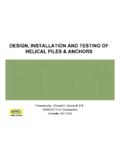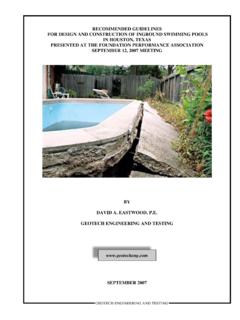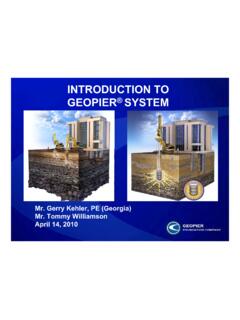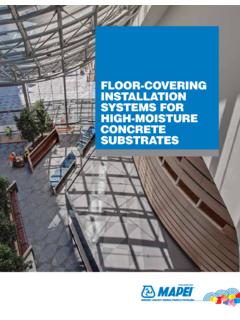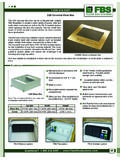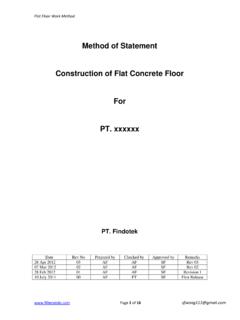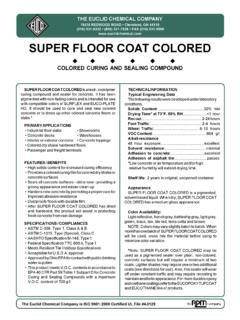Transcription of Concrete Floor Covering Failures - Foundation
1 18 August 2004 FPAWJEC oncrete FloorCovering FailuresB. Lee Lawrence, Lee Lawrence, , Janney, Elstner Associates, , Janney, Elstner Associates, Pond Springs Road, Suite 10713581 Pond Springs Road, Suite 107 Austin, Texas 78729 Austin, Texas 7872918 August 2004 FPAWJEI ntroduction Background:Background: Contributors to failure Mechanisms of failure Unique Floor Covering failure Case Studies:Unique Floor Covering failure Case Studies: Alkali-silica reaction Sulfate attack Osmotic pressure Chemical attack (alkaline hydroxide)18 August 2004 FPAWJEC ontributors to failure The Commonly Accused Culprits Improper Application and Material ProblemsImproper Application and Material Problems Vapor and Vapor PressureVapor and Vapor Pressure Moisture (liquid)Moisture (liquid)18 August 2004 FPAWJEA pplication and Material Problems Application Issues:Application Issues: Slab construction/design deficiencies Improper surface preparation Installation at elevated moisture-vapor transmissionrates Improper mixing Material ProblemsMaterial Problems Material incompatibility Improper formulation18 August 2004 FPAWJEV apor and Vapor Pressure Vapor - Vapor - a substance in the gaseous state, as a substance in the gaseous state, asdistinguished from solid or liquid matterdistinguished from solid or liquid matter Water Vapor Pressure Water Vapor Pressure caused by a water vapor caused by a water vaporgradient, movement from areas of high humidity togradient, movement from areas of high humidity toareas of low humidityareas of low humidity Moisture-vapor pressure in a Floor slab is generallyvery low relative to a well adhered Floor Covering Moisture-vapor emission rates can be assessedqualitatively (ASTM D4263 - plastic sheet method)
2 And quantitatively (ASTM F1869 - anhydrous calciumchloride method) Moisture vapor can condense to water in a vapor can condense to water in a August 2004 FPAWJES ources of Water in a Slab on Grade Moisture - If the Concrete is Moisture - If the Concrete is drydry at the time of application and at the time of application andremains so during service of the Floor Covering system, most typesremains so during service of the Floor Covering system, most typesof Floor Covering Failures will never occur!of Floor Covering Failures will never occur! Sources of Water Sources of Water residual mixing water from the Concrete , curing residual mixing water from the Concrete , curingwater, washing water, rainfall, condensation of water vapor, andwater, washing water, rainfall, condensation of water vapor, andwater from slab substrate via hydrostatic pressure, capillary rise, orwater from slab substrate via hydrostatic pressure, capillary rise, orosmosis.
3 (Ref. June/April 2003 Concrete International)osmosis. (Ref. June/April 2003 Concrete International) Most Floor coverings are sensitive to presence of moisture atMost Floor coverings are sensitive to presence of moisture atapplication and some continue to be sensitive to moisture evenapplication and some continue to be sensitive to moisture evenafter application and curingafter application and curing The availability of moisture can cause other mechanisms of distressThe availability of moisture can cause other mechanisms of distressto occur, which can be disruptive to Floor coveringsto occur, which can be disruptive to Floor coverings18 August 2004 FPAWJEM echanisms of failure Alkali-silica ReactionAlkali-silica Reaction Sulfate AttackSulfate Attack Osmotic PressureOsmotic Pressure Chemical Attack (alkaline hydroxide)Chemical Attack (alkaline hydroxide)18 August 2004 FPAWJEF ailure MechanismsAlkali-Silica Reaction (ASR)
4 Alkali-Silica Reaction (ASR) A reaction between reactiveA reaction between reactivesiliceous aggregate particlessiliceous aggregate particlesand hydroxyls of the poreand hydroxyls of the poresolutionsolution High alkali content of portlandHigh alkali content of portlandcementcement Reactive siliceous aggregateReactive siliceous aggregate Sufficient moistureSufficient moisture18 August 2004 FPAWJEF ailure MechanismsSulfate AttackSulfate Attack A reaction between sulfateA reaction between sulfateions normally from an externalions normally from an externalor internal source and calciumor internal source and calciumaluminate and calciumaluminate and calciumhydroxide of the cement pastehydroxide of the cement paste Sulfate attack can causeSulfate attack can causeexpansion, cracking, andexpansion, cracking, andcrumbling of pastecrumbling of paste18 August 2004 FPAWJEF ailure MechanismsOsmotic BlisteringOsmotic Blistering Associated with osmosis, inAssociated with osmosis, inwhich a solvent (water) passeswhich a solvent (water) passesthrough a semi-permeablethrough a semi-permeablemembrane ( Concrete surface)membrane ( Concrete surface)from a dilute solution to afrom a dilute solution to amore concentrated solutionmore concentrated solution Liquid volume increases asLiquid volume increases asosmotic pressure builds up,osmotic pressure builds up,causing debonding/blisteringcausing debonding/blistering18 August 2004 FPAWJEF ailure MechanismsChemical Attack (Saponification)Chemical Attack (Saponification)
5 Portland cement and wet portlandPortland cement and wet portlandcement Concrete have a high pHcement Concrete have a high pHtypically ranging between 13 andtypically ranging between 13 and1414 Calcium, sodium, and potassiumCalcium, sodium, and potassiumhydroxide are solublehydroxide are solubleconstituents of portland cementconstituents of portland cement Non-carbonated surfaces orNon-carbonated surfaces orsurfaces contaminated withsurfaces contaminated withtransported alkaline hydroxidestransported alkaline hydroxidescan result in a high pHcan result in a high pHenvironment that can causeenvironment that can causedegradation of some adhesivesdegradation of some adhesives18 August 2004 FPAWJET ypical Investigation Methods Condition survey (look, touch,Condition survey (look, touch, )) Moisture-vapor emission testingMoisture-vapor emission testing(ASTM F1869)(ASTM F1869) Pull-off testing (ASTM D4541, ACIPull-off testing (ASTM D4541, ACI503R)503R) Concrete Petrography - ToConcrete Petrography - Toestimate mix proportions andestimate mix proportions andidentify problems associated withidentify problems associated withmixing, finishing, and deleteriousmixing, finishing, and deleteriousdistress mechanismsdistress mechanisms Chemical studies for determiningChemical studies for determiningpH and compositionalpH and compositionalcharacteristics of concretecharacteristics of concretesurfaces (ASTM D4262,surfaces (ASTM D4262,XRD/SEM-EDX)XRD/SEM-EDX)18 August 2004 FPAWJEw/c18 August 2004 FPAWJEAir voids18 August 2004 FPAWJECase Study No.
6 1 - ASR Induced FloorCovering FailureGeneral Observations: Epoxy coating applied on a two-year-old concreteslab with vapor barrier underneath Scaling and blistering observed within several monthsof application Cores were taken and examined petrographically Concrete was of good quality Near-surface ASR was identified involving finerhyolite particles No ASR detected at the interior of the concrete18 August 2004 FPAWJEE poxy Floor system18 August 2004 FPAWJE cementitious18 August 2004 FPAWJER egion of debonded epoxy18 August 2004 FPAWJEC oncrete entrance18 August 2004 FPAWJET ypical surface scaling in exterior concrete18 August 2004 FPAWJES ample cross-section at disbonded area18 August 2004 FPAWJEASR gel at interface18 August 2004 FPAWJER eactive aggregate near surface18 August 2004 FPAWJEASR gel on Concrete surface18 August 2004 FPAWJEASR Induced Floor Covering FailureProbable causes of near-surface ASR.
7 Segregation resulting in reactive aggregateconcentrated only in the near-surface region Significant moisture gradient with high near-surface moisture content Alkali gradient18 August 2004 FPAWJEASR Induced Floor Covering FailureChemical testing: Acid soluble and water solublealkali (acid soluble)(acid soluble) to 43-1/2 to to 1/20 to 1/2 NaNa22 OOeqeq(water soluble)(water soluble)Depth (in.)Depth (in.)Bleed water and/or upward moisture movementtransported alkalis to the near-surface region ofthe August 2004 FPAWJECase Study No. 2 - Floor Covering Failures dueto Sulfate AttackGeneral Observations:General Observations: Vinyl tiles and sheet vinyl were installed on a slab-on-grade less thanVinyl tiles and sheet vinyl were installed on a slab-on-grade less thantwo years oldtwo years old Localized debonding occurred within a few monthsLocalized debonding occurred within a few months Petrographic examinations were performed on Concrete cores takenPetrographic examinations were performed on Concrete cores takenfrom the slab.
8 The Concrete was the slab. The Concrete was normal. A shrinkage compensating mortar was present above the concreteA shrinkage compensating mortar was present above the Concrete Vinyl Floor Covering was installed with an adhesive that was appliedVinyl Floor Covering was installed with an adhesive that was appliedwith a notched trowelwith a notched trowel Abundant ettringite deposits were observed between the strips ofAbundant ettringite deposits were observed between the strips ofadhesive and in the leveling mortaradhesive and in the leveling mortar18 August 2004 FPAWJEC oncrete with leveling mortar18 August 2004 FPAWJEM ultiple layers of leveling mortar18 August 2004 FPAWJEBand of ettringite in leveling mortar18 August 2004 FPAWJEE ttringite along adhesive strips18 August 2004 FPAWJEE ttringite and adhesive18 August 2004 FPAWJEF loor Covering Failures due to Sulfate AttackCause of failure :Cause of failure .
9 The shrinkage compensating mortar contained abundantThe shrinkage compensating mortar contained abundantcalcium aluminate and calcium sulfatecalcium aluminate and calcium sulfate Moisture in the adhesive resulted in dissolving andMoisture in the adhesive resulted in dissolving andreprecipitation of these components, forming ettringite inreprecipitation of these components, forming ettringite inthe interfacethe interface The resulting internal sulfate attack caused the debondingThe resulting internal sulfate attack caused the debondingof the vinyl flooringof the vinyl flooring18 August 2004 FPAWJECase Study No. 3 - Floor Covering FailureCaused by Osmotic BlisteringGeneral Observations:General Observations: A six-year-old polymeric coating in a wastewater pitA six-year-old polymeric coating in a wastewater pitexhibited debonding and blistering on the walls and floorexhibited debonding and blistering on the walls and floorof the pitof the pit Coating included a thin epoxy base coating and a Coating included a thin epoxy base coating and a high-high-buildbuild polymeric top coat with a total applied thickness polymeric top coat with a total applied thicknessranging between 60 to 80 milsranging between 60 to 80 mils Surface preparation by sand blastingSurface preparation by sand blasting Moisture desiccation employed by forced-airMoisture desiccation employed by forced-airdehumidifiersdehumidifiers Moisture-vapor emissions exceeded manufacturerMoisture-vapor emissions exceeded manufacturer ssrecommended limits at time of applicationrecommended limits at time of
10 Application18 August 2004 FPAWJECase Study No. 3 - Floor Covering FailureCaused by Osmotic Blistering cont dGeneral Observations:General Observations: Application followed all other manufacturerApplication followed all other manufacturer ssrecommendationsrecommendations Petrographic examination indicated that the concretePetrographic examination indicated that the concretewas of good qualitywas of good quality Blisters were often fluid-filled and under pressureBlisters were often fluid-filled and under pressure Disbondment observed between epoxy base coat andDisbondment observed between epoxy base coat andconcrete and between top coat and epoxy base coatconcrete and between top coat and epoxy base coat Indication of possible formulation problemsIndication of possible formulation problems18 August 2004 FPAWJEB reach of coating18 August 2004 FPAWJET ypical fluid-filled blisters18 August 2004 FPAWJEB listers under the ceiling18 August 2004 FPAWJEH olidays below the coating18 August 2004 FPAWJEB listers on a core from
